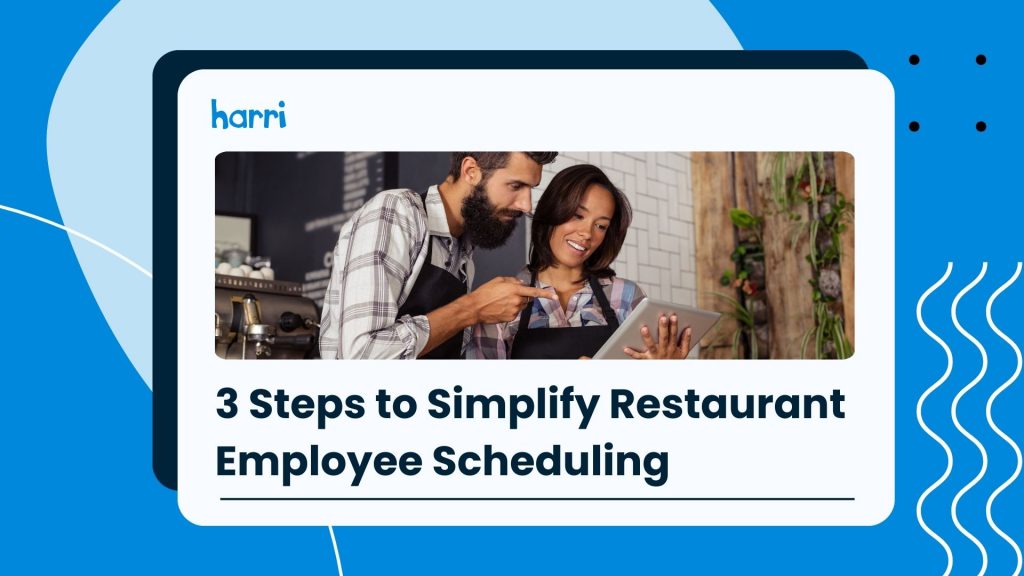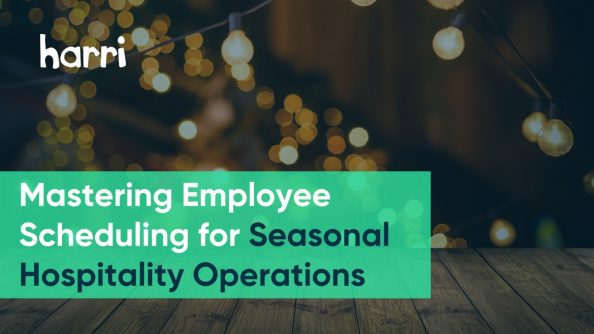From Scramble to Serenity: 3 Steps to Simplify Restaurant Employee Scheduling

- By Harri Insider Team | August 8, 2024
Each week, the balancing act of accommodating employee availability, skill sets, and shift preferences often evolves into a time-consuming, error-prone endeavor. The result? Stressed managers, overworked staff, and a less-than-optimal guest experience. Fortunately, there are three transformative steps that can streamline your scheduling process, enhance employee satisfaction, and boost your bottom line.
Step 1: Ditch the Manual Efforts
Relying on spreadsheets and paper calendars to manage schedules is a recipe for frustration. The endless adjustments, last-minute changes, and inevitable conflicts can consume hours of a manager’s time, pulling them away from more strategic activities. This outdated approach not only leads to errors but also saps the energy needed to focus on guests and overall operations.
Adopting automated scheduling systems changes the game. These tools simplify shift planning, drastically cut down errors, and allow managers to reclaim their time for more impactful tasks. Instead of juggling endless details, managers can now enhance the guest experience and drive the business forward.
Automated systems also deliver valuable insights into labor costs and employee performance, facilitating smarter, data-driven decisions. When employees can manage their own schedules and requests, their satisfaction and engagement increase. Empowering managers with these systems frees up time for strategic initiatives like staff training and customer engagement.

Step 2: Using Data to Drive Scheduling Efficiency
Effective scheduling in the hospitality industry hinges on the smart use of both implicit and explicit data. This dual approach ensures that staffing decisions are grounded in comprehensive insights from both operational metrics and employee feedback.
By integrating historical sales trends with direct employee input, managers can craft schedules that are both efficient and employee-friendly. For example, while sales data highlights peak times needing more staff, considering employee preferences and compliance requirements ensures these schedules are practical and legal.
In a real-world application, a manager might start with sales data to forecast a busy Friday night and initially schedule accordingly. They then fine-tune this plan based on who excels under pressure or who prefers evening shifts, ensuring optimal performance and satisfaction. Compliance data further guarantees that all shifts adhere to legal standards, avoiding costly fines and promoting fair work conditions.
Machine learning enhances this process by continuously analyzing both types of data to uncover patterns and predict needs. These systems can adapt schedules in real time to fluctuations in customer traffic, ensuring optimal staffing levels at all times. The result is heightened operational efficiency, happier employees, and a superior guest experience.
Examples of Implicit and Explicit Data
Implicit Data:
- Historical sales trends: Patterns in sales over time
- Transaction counts: Number of transactions during specific periods
- Customer satisfaction data: Feedback from customers on their experience
- Employee satisfaction data: Metrics on employee morale and engagement
- Queue length and wait times: Data on customer wait times
- Labor costs vs. forecast: Comparison of actual labor costs to predicted costs
Explicit Data:
- Employee feedback: Direct input from employees about their work experience
- Manager feedback: Insights from managers on team performance
- Compliance adherence records: Documentation of compliance with labor laws
- Service quality surveys: Surveys assessing the quality of service provided
- Shift preferences and availability: Employee preferences and availability for shifts

Step 3: Prioritizing Employee Needs and Flexibility
Several challenges hospitality workers face, such as limited time off, lack of input on schedules, and unsociable working hours, stem from scheduling frustrations and directly impact morale and retention. Addressing these issues is crucial for employee well-being and maintaining a profitable and efficient operation.
Giving employees more control over their schedules promotes a healthy work-life balance, reducing burnout and turnover. When employees can easily swap shifts and manage their availability, they remain more engaged and productive. This increased satisfaction translates into better customer service and repeat business.
Advanced scheduling technology is key to providing this flexibility. Systems that allow for easy shift trades, time-off requests, and real-time updates create a dynamic and responsive scheduling environment. By integrating peak business hours with employee preferences, these tools ensure optimal coverage while meeting the needs of the staff. This approach simplifies the scheduling process for managers and also fosters a more positive and productive work environment.
Simplify, Empower, Profit
By moving from manual scheduling to automated systems, leveraging comprehensive data, and prioritizing flexibility for employees, restaurant managers can transform the chaotic scheduling process into a streamlined operation. These steps lead to empowered employees who are more engaged and productive. Implementing these changes will directly enhance staff retention, drive operational efficiency, and ultimately elevate the overall guest experience.
Operators rely on Harri’s intelligent scheduling software to simplify the complex task of workforce management. Designed specifically for restaurants, hotels, and retailers, Harri’s integrated approach optimizes staff schedules by leveraging historical sales, activity-based methodology, and demand forecasting. This ensures accuracy and efficiency, tapping into catering, reservation, weather, events, and localized data for precise labor adjustments. By saving managers hours in administrative tasks, Harri enables them to build schedules that drive optimal economics and performance. Discover how Harri can transform your scheduling process and boost your operational efficiency.



















